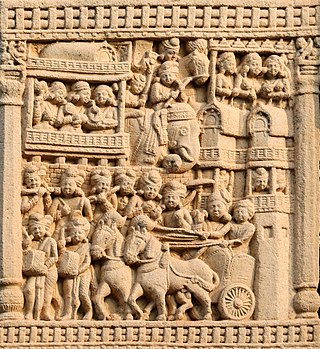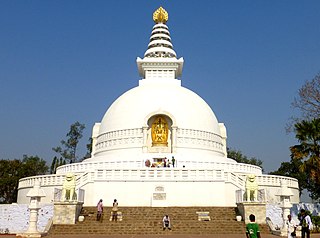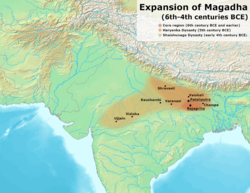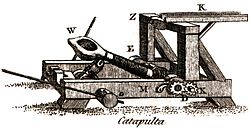
Magadha also called the Kingdom of Magadha or the Magadha Empire, was a kingdom and empire, and one of the sixteen Mahajanapadas, 'Great Kingdoms' of the Second Urbanization, based in southern Bihar in the eastern Ganges Plain, in Ancient India. Magadha was ruled by the Brihadratha dynasty, the Haryanka dynasty, the Shaishunaga dynasty, the Nanda dynasty, the Mauryan dynasty, the Shunga dynasty and the Kanva dynasty. It lost much of it territories after being defeated by the Satavahanas of Deccan in 28 BC and was reduced to a small principality around Pataliputra. Under the Mauryas, Magadha became a pan-Indian empire, covering large swaths of the Indian subcontinent and Afghanistan.

Bimbisāra or རྒྱལ་པོ་གཟུགས་ཅན་སྙིང་པོ་ (Tibetan) or Shrenika and Seniya in the Jain histories was the King of Magadha and belonged to the Haryanka dynasty. He was the son of Bhattiya. His expansion of the kingdom, especially his annexation of the kingdom of Anga to the east, is considered to have laid the foundations for the later expansion of the Mauryan Empire.

Ajatasattu or Ajatashatru in Buddhist tradition, or Kunika and Kuniya in the Jain histories, was one of the most important kings of the Haryanka dynasty of Magadha in East India. He was the son of King Bimbisara and was a contemporary of both Mahavira and Gautama Buddha. He forcefully took over the kingdom of Magadha from his father and imprisoned him. He fought a war against the Vajjika League, led by the Licchavis, and conquered the republic of Vaishali. The city of Pataliputra was formed by fortification of a village by Ajatashatru.

The Nanda dynasty was the third ruling dynasty of Magadha in northern Indian subcontinent during the fourth century BCE and possibly also during the fifth century BCE. The Nandas overthrew the Shaishunaga dynasty, and expanded the empire to include a larger part of northern India. Ancient sources differ considerably regarding the names of the Nanda kings and the duration of their rule, but based on the Buddhist tradition recorded in the Mahāvaṃsa, they appear to have ruled during c. 345–322 BCE, although some theories date the start of their rule to fifth century BCE.

The Shishunaga dynasty was the second ruling dynasty of Magadha, an empire in ancient India. According to the Hindu Puranas, this dynasty was the second ruling dynasty of Magadha, succeeding Nagadashaka of the Haryanka dynasty.

Rajgir, meaning "The City of Kings," is a historic town in the district of Nalanda in Bihar, India. As the ancient seat and capital of the Haryanka dynasty, the Pradyota dynasty, the Brihadratha dynasty and the Mauryan Empire, as well as the dwelling ground of such historical figures as The Buddha and The Mahavira, the city holds a place of prominence in Hindu, Buddhist and Jain scriptures. As of 2011, the population of the town was reported to be 41,000 while the population in the community development block was about 88,500.

Kosala, sometimes referred to as Uttara Kosala was one of the Mahajanapadas of ancient India. It emerged as a small state during the Late Vedic period and became one of the earliest states to transition from a lineage-based society to a monarchy. By the 6th century BCE, it had consolidated into one of the four great powers of ancient northern India, along with Magadha, Vatsa, and Avanti.

The Mahājanapadas were sixteen kingdoms or aristocratic republics that existed in ancient India from the sixth to fourth centuries BCE, during the second urbanisation period.

Anga was an ancient Indo-Aryan tribe of eastern India whose existence is attested during the Iron Age. The members of the Aṅga tribe were called the Āṅgeyas.

Vatsa or Vamsa was one of the sixteen Mahajanapadas of Uttarapatha of ancient India mentioned in the Aṅguttara Nikāya.
Shishunaga was the founder of the Shishunaga dynasty of the Magadha Empire in the present day northern India. Initially, he was an amatya (official) of the Magadha empire under the Haryanka dynasty. He was placed on the throne by the people who revolted against the Haryanka dynasty rule. According to the Puranas, he placed his son at Varanasi and himself ruled from Girivraja (Rajagriha). He was succeeded by his son Kalashoka (Kakavarna).

Mahapadma Nanda, according to the Puranas, was the first Emperor of the Nanda Empire of ancient India. The Puranas describe him as a son of the last Shaishunaga king Mahanandin and a Shudra woman. These texts credit him with extensive conquests that expanded the Empire far beyond the Magadha region. The different Puranas variously give the length of his reign as 28 or 88 years, and state that his eight sons ruled in succession after him.

Pradyota dynasty, also called Prthivim Bhoksyanti, was a ruling dynasty of Avanti, founded by Pradyota, after his father Punika, a minister in the court of the king of Ujjaini, the northern part of the former Avanti kingdom, and placed his own son on the throne in 536 BCE.

Pasenadi was an Aikṣvāka ruler of Kosala. Sāvatthī was his capital. He succeeded after Sanjaya Mahākosala. He was a prominent Upāsaka of Gautama Buddha, and built many Buddhist monasteries for the Buddha.
Kosala Devī was Empress consort of the Magadha Empire as the first wife of Emperor Bimbisara. She was born a princess of Kashi and was the sister of King Prasenajit. Her first name is Bhadra-śrī.
Vajira was Empress of the Magadha Empire as the principal consort of Emperor Ajatashatru. She was the mother of her husband's successor, Emperor Udayibhadra.

Udayin also known as Udayabhadra was a king of Magadha in ancient India. According to the Buddhist and Jain accounts, he was the son and successor of the Haryanka king Ajatashatru. Udayin laid the foundation of the city of Pataliputra at the confluence of two rivers, the Son and the Ganges. He shifted his capital from Rajagriha to Pataliputra due to the latter's central location in the empire.
Kalashoka or Kakavarna was the son and successor of Shishunaga. He divided his kingdom between his ten sons and crowned his ninth son, Nandivardhana as the king of Magadha.
The Magadha-Vajji War was a conflict between the Haryanka dynasty of Magadha and the neighbouring Vajjika League which was led by the Licchavikas. The conflict is remembered in both Buddhist and Jain traditions. The conflict ended in defeat for the Vajjika League, and the Māgadhīs annexing their territory.

The Avanti-Magadhan war was fought between the Haryanka Dynasty of Magadha and Avanti for domination over much of North India.














